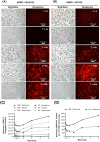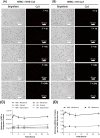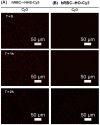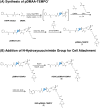The Effect of Covalently-Attached ATRP-Synthesized Polymers on Membrane Stability and Cytoprotection in Human Erythrocytes
- PMID: 27331401
- PMCID: PMC4917246
- DOI: 10.1371/journal.pone.0157641
The Effect of Covalently-Attached ATRP-Synthesized Polymers on Membrane Stability and Cytoprotection in Human Erythrocytes
Abstract
Erythrocytes have been described as advantageous drug delivery vehicles. In order to ensure an adequate circulation half-life, erythrocytes may benefit from protective enhancements that maintain membrane integrity and neutralize oxidative damage of membrane proteins that otherwise facilitate their premature clearance from circulation. Surface modification of erythrocytes using rationally designed polymers, synthesized via atom-transfer radical polymerization (ATRP), may further expand the field of membrane-engineered red blood cells. This study describes the fate of ATRP-synthesized polymers that were covalently attached to human erythrocytes as well as the effect of membrane engineering on cell stability under physiological and oxidative conditions in vitro. The biocompatible, membrane-reactive polymers were homogenously retained on the periphery of modified erythrocytes for at least 24 hours. Membrane engineering stabilized the erythrocyte membrane and effectively neutralized oxidative species, even in the absence of free-radical scavenger-containing polymers. The targeted functionalization of Band 3 protein by NHS-pDMAA-Cy3 polymers stabilized its monomeric form preventing aggregation in the presence of the crosslinking reagent, bis(sulfosuccinimidyl)suberate (BS3). A free radical scavenging polymer, NHS-pDMAA-TEMPO˙, provided additional protection of surface modified erythrocytes in an in vitro model of oxidative stress. Preserving or augmenting cytoprotective mechanisms that extend circulation half-life is an important consideration for the use of red blood cells for drug delivery in various pathologies, as they are likely to encounter areas of imbalanced oxidative stress as they circuit the vascular system.
Conflict of interest statement
Figures








Similar articles
-
Amelioration of glucose induced hemolysis of human erythrocytes by vitamin E.Chem Biol Interact. 2011 Sep 5;193(2):149-53. doi: 10.1016/j.cbi.2011.06.004. Epub 2011 Jun 26. Chem Biol Interact. 2011. PMID: 21736874
-
Modulated red blood cell survival by membrane protein clustering.Mol Cell Biochem. 1995 Mar 9;144(1):53-9. doi: 10.1007/BF00926740. Mol Cell Biochem. 1995. PMID: 7791745
-
Engineering exosome polymer hybrids by atom transfer radical polymerization.Proc Natl Acad Sci U S A. 2021 Jan 12;118(2):e2020241118. doi: 10.1073/pnas.2020241118. Proc Natl Acad Sci U S A. 2021. PMID: 33384328 Free PMC article.
-
Hemoglobin s polymerization and red cell membrane changes.Hematol Oncol Clin North Am. 2014 Apr;28(2):155-79. doi: 10.1016/j.hoc.2013.12.002. Epub 2014 Jan 22. Hematol Oncol Clin North Am. 2014. PMID: 24589260 Review.
-
The microenvironment can shift erythrocytes from a friendly to a harmful behavior: pathogenetic implications for vascular diseases.Cardiovasc Res. 2007 Jul 1;75(1):21-8. doi: 10.1016/j.cardiores.2007.03.007. Epub 2007 Mar 14. Cardiovasc Res. 2007. PMID: 17412313 Review.
Cited by
-
Cell-mediated targeting drugs delivery systems.Drug Deliv. 2020 Dec;27(1):1425-1437. doi: 10.1080/10717544.2020.1831103. Drug Deliv. 2020. PMID: 33096949 Free PMC article. Review.
-
Immune cells: potential carriers or agents for drug delivery to the central nervous system.Mil Med Res. 2024 Mar 29;11(1):19. doi: 10.1186/s40779-024-00521-y. Mil Med Res. 2024. PMID: 38549161 Free PMC article. Review.
-
Coatings on mammalian cells: interfacing cells with their environment.J Biol Eng. 2019 Jan 17;13:5. doi: 10.1186/s13036-018-0131-6. eCollection 2019. J Biol Eng. 2019. PMID: 30675178 Free PMC article. Review.
References
-
- Siems WG, Sommerburg O, Grune T. Erythrocyte free radical and energy metabolism. Clinical nephrology. 2000;53(1 Suppl):S9–17. - PubMed
-
- Szweda-Lewandowska Z, Krokosz A, Gonciarz M, Zajeczkowska W, Puchala M. Damage to human erythrocytes by radiation-generated HO* radicals: molecular changes in erythrocyte membranes. Free radical research. 2003;37(10):1137–43. - PubMed
MeSH terms
Substances
LinkOut - more resources
Full Text Sources
Other Literature Sources
Miscellaneous

